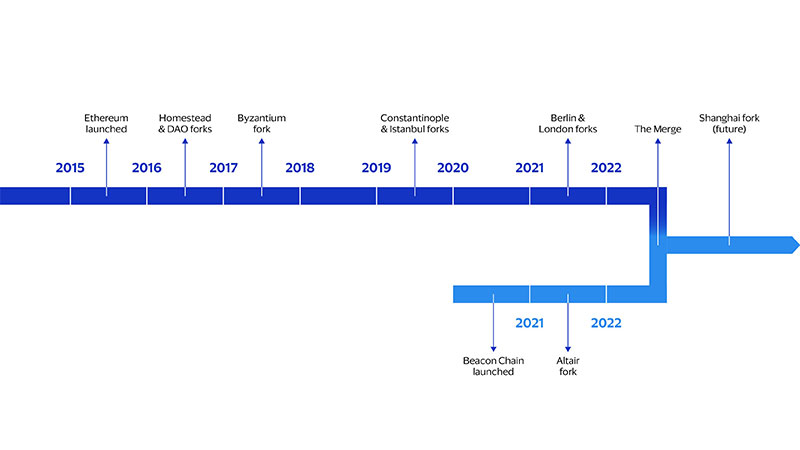Ethereum 2.0: more sustainable, secure, and scalable
Even though The Merge was Ethereum's most difficult upgrade to date, it is not expected to be the Ethereum’s last significant upgrade. Starting with The Merge, the network intends to implement Ethereum's core mantra of sustainability, security, and scalability. These three tenets are essential for any blockchain network that aims to serve as a global settlement layer. If Ethereum's updates bring the decentralized network closer to these goals, it will be a huge step forward for the blockchain ecosystem as a new payment rail on which the future of money movement can run, with the advantages of being available 24/7, atomic settlement with almost instant finality for each transaction, and future programmable features.
Sustainability
The Merge event had clear advantages for the sustainability of the Ethereum blockchain. The reduction of Ethereum's carbon footprint while retaining the network's economic properties will be significant for institutional investors, especially for traditional organizations with ESG mandates and portfolio requirements.
PoW’s reliance on computational power quickly adds up when there are thousands of miners operating, which leads to significant energy consumption and raises environmental concerns. PoS does not have this drawback: It is estimated that transitioning from PoW to PoS will decrease Ethereum's energy consumption by 99.95%.⁴ It is the first demonstration of a system of this size that reduces carbon footprints solely through innovation and redesign.
Security
Furthermore, PoW “mining” usually relies on specialized machinery that is expensive and raises the barrier of entry whereas participants only need to own a specific token for staking. Currently, the Beacon Chain’s PoS protocol requires users to hold 32 ETH to be able to set up their own validator node and stake their tokens. This is still a considerable investment, but there are third-party staking pool options for people who cannot meet that amount, meaning people need a much smaller initial investment to start staking.⁵ This lower threshold is the basis for claims of increased decentralization and security with PoS.
The developments are encouraging, but it is still important to think critically about these next steps for Ethereum. One important point is that while the testnets can imitate the underlying technology of Ethereum mainnet, they can’t simulate the underlying market conditions and behavior. When there are tokens of actual value on the line, both honest users and attackers have different incentives than in a testnet. Furthermore, it is also important to consider the relationship between PoS and decentralization.
While PoS removes the computational complexity of PoW and makes it possible for more people to take part in securing the network, a significant chunk of the ETH that goes into staking can still concentrate on the hands of very few validators. This is especially relevant with the case of staking pools, where a few smart contracts or off-chain entities can become concentration points for a large proportion of staked ETH. Therefore, we should not take the transition to PoS as a simple guarantee for more decentralization. Rather, we should observe the network metrics to help make sure security and decentralization don’t regress in the long run.
Scalability
It is important to note that The Merge was not supposed to bring about a significant change in Ethereum's scalability. The primary measure of scalability is the number of transactions the network can process in a second, or TPS. Ethereum has a TPS of around 15.⁶ PoS doesn’t instantly increase the TPS or make consensus faster, only less energy intensive. To understand why, consider this: If it takes a specific time on average, let’s say 15 seconds, to mine a block under PoW, and if a block proposal and voting by validators take place every 15 seconds under PoS, then these two methods will produce blocks at roughly the same rate. This is essentially the case with Ethereum: before The Merge the average time between blocks was about 13 seconds, and after the transition to PoS, a block slot, which is the same as one block, started to tick every 12 seconds.³ The increased transaction throughput will be possible only with further upgrades and innovations down the line, namely sharding and layer 2 scaling solutions, which The Merge only paves the way for. Transaction fees, which are directly related to network congestion and, by extension, to transaction throughput, remained the same.
